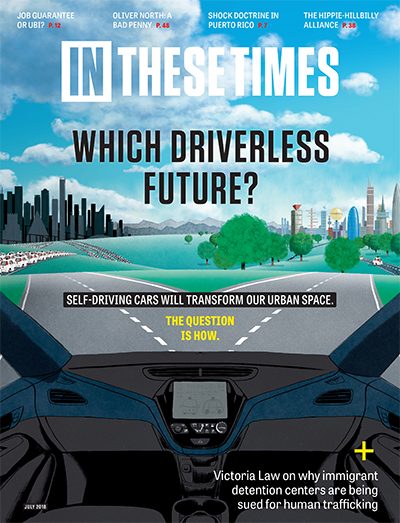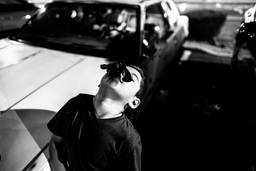Turning Abandoned Gold Mines Into Wheelchair Paths
How a motley alliance of hippies and hillbillies transformed a California mining town.
Stephanie Sauer

My parents liked to tell me that I rolled along the United States’ first wheelchair-accessible wilderness trail before I was born, my father’s thin legs supporting my pregnant mother on his lap. I spent the rest of my childhood walking that trail, often at my father’s side, and it became a favorite gathering place for the disability rights advocates who populated my early life.
Independence Trail was built in the early 1980s using abandoned mining flumes, wooden channels that carried debris away from the hydraulic mine at Malakoff Diggins. The trail’s construction speaks to more than savvy repurposing. The trajectory of the region from a site of environmental destruction to a beacon of stewardship — in 2019, Malakoff Diggins State Historic Park will become California’s first solar-powered state park — is testament to the power of the slow, faceto-face interchange of ideas. As Rebecca Solnit reminds us in Hope in the Dark, “Politics arises out of the spread of ideas and the shaping of imaginations.”
Since the 1960s back-to-the-land movement came to the San Juan Ridge, interactions between the established hillbilly enclaves, like where I grew up, and countercultural newcomers have altered lives, politics and imaginations.
In the late 1800s, in pursuit of gold, the North Bloomfield Gravel Mining Company used high-pressure water cannons to blast away entire hillsides in the Western Sierra Nevadas. The company used more than 100 miles of canals to carry away the toxic debris, moving a total of 41 million cubic yards of earth and helping to flood entire cities and clog waterways as far south as San Francisco Bay.
In 1884, in response to the mine’s devastating runoff, the U.S. Ninth Circuit Court effectively prohibited hydraulic mining. It was the first time the federal government regulated business on environmental grounds. Operations at Malakoff Diggins continued illegally for years, until two injunctions finally forced the mine out of business.
The land at Malakoff remained its own planet, a haunted afterbirth of genocide and greed. Hillsides once covered in evergreens stood bare for nearly a century. Nearby mining towns were abandoned until the Great Depression, when penniless squatters occupied the dilapidated structures. Between the 1930s and 1960s, the hills were home to conservative farming families, mountain men, loggers and those of the Nisenan tribe who survived the Gold Rush’s state-sanctioned call to “exterminate them.”
In 1969, followers of the Indian yogi Paramahansa Yogananda migrated to the region and founded the “world brotherhood colony” Ananda Village. News of the village reached Joan Didion, who wrote in her 1967 essay, “Slouching Toward Bethlehem,” “We drink some more green tea and talk about going up to Malakoff Diggings [sic] in Nevada County because some people are starting a commune there and Max thinks it would be a groove to take acid in the diggings.”
Taking acid in the Diggins is, in fact, a groove. Or so I was told by a friend’s hippie parents in the 1990s as we wandered among iron-stained siltstone and purple-limbed shrubs.
My parents were not like those parents. They were hill kids turned cabinet makers, the offspring of loggers and minnow farmers. My father’s grandparents arrived on the San Juan Ridge during the Dust Bowl with other poor farmers who settled in abandoned mining towns with names like Humbug and Rough & Ready and Jackass Flats. To be from the Ridge became synonymous with being Okie, not a good thing in the 1930s.
Some Ridge kids went to war and came back armed with the G.I. Bill, bought houses in town and began their pursuit of the American Dream. My parents were given a plot of family land when they married in 1980, built a house on it, voted Republican, sold Amway products. They all disparaged the arrival of the longhairs. Until, that is, my father met Sam Dardick.
In the 1960s, disillusioned with St. Louis suburban life, Sam and his wife Geeta packed up their three children and Sam’s wheelchair and set out on the Hippie Trail from Europe to South Asia. After several years in India, they returned to the states, where Sam got a job as a planner for Ananda Village, liaising with the surrounding community. He and Geeta decided to build their own offgrid home, complete with rotating crops that Sam could cultivate while seated in his chair.
Noticing that my father was one of the few folks who used a wheelchair on the Ridge, Sam introduced himself and extended an invitation to play tennis. They eventually formed the Nevada County Wheelchair Sports Association, and soon, Sam and Geeta were as close as kin.
Hippies like the Dardicks brought their revolutionary thinking into a deeply conservative backwoods, where clear-cutting and gravel dumping were again threatening the land. Poet Gary Snyder, who lived on the Ridge, urged a return to public commons and place-based living; he and others put these ideas to practice. Hundreds of “dropouts” erected homes, lived off the land and organized large festivals to celebrate each new season. The South Yuba River Citizens’ League (SYRCL) formed to protect the local watershed from dams. By emphasizing a love for rural life and the river, activists built coalitions across political lines.
Two of the newcomers, John and Sallie Olmsted, established the conservation nonprofit Sequoya Challenge. John wanted to build a wilderness path that his friends could access in their wheelchairs, and thus was born the Independence Trail. Studying old maps to find a site, he noticed the abandoned Excelsior Canal.
The Olmsteds and a group of other local residents initiated the construction of several wide, level paths that connected the old wooden flumes on Excelsior Canal together in more than 3.5 miles of accessible trail. My father joined the nonprofit’s board, his first experience working on a social cause outside his own family. It was here he began to learn to navigate government policies, raise funds and build effective — if unlikely — coalitions.
Soon, with Sam’s encouragement, he left his cabinetry business to help manage FREED, a disability advocacy group. Decades later, he went on to direct the California Department of Rehabilitation, the largest department of its kind in the nation.
“That was the whole thing about the San Juan Ridge community, they really made an effort to blend ideals,” my father recalls. “John was great about getting all these conservative stakeholders to give him their time and resources.” John, persistent but respectful, even convinced my grandfather and other conservative logging outfits to donate timber for the rebuilding of several flumes. The trail was completed in 1982.
Over the years, the Right rolled back many environmental gains, winning battles over dam removal and development. An anti-logging campaign to protect the spotted owl created rifts where there were once budding alliances. Yet most residents were unified by a desire for their family and friends with disabilities, particularly Vietnam vets, to live in an accessible community.





